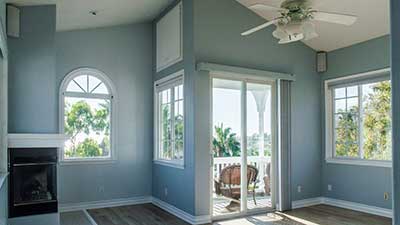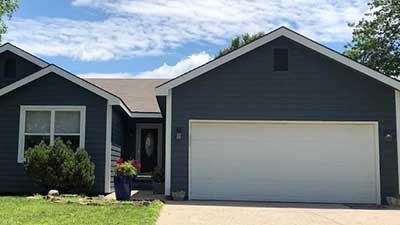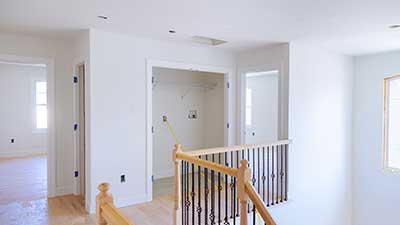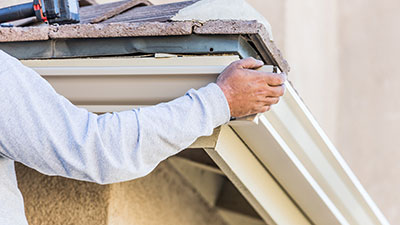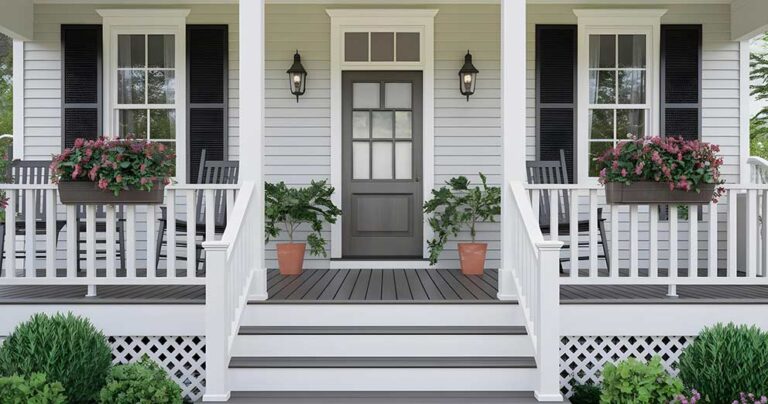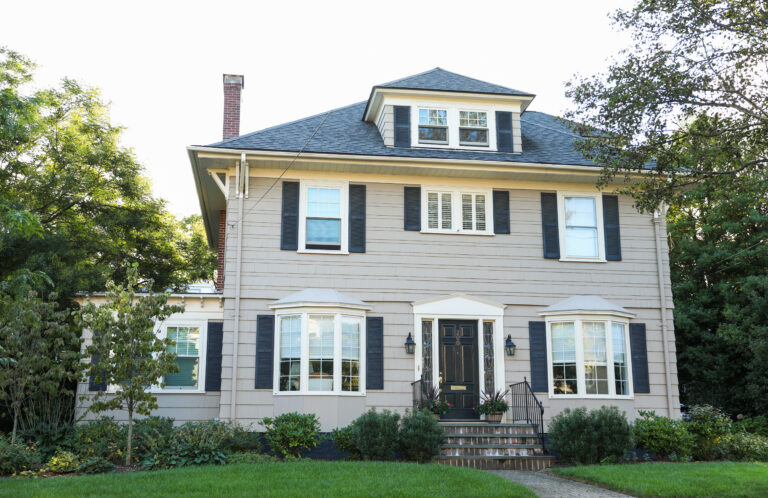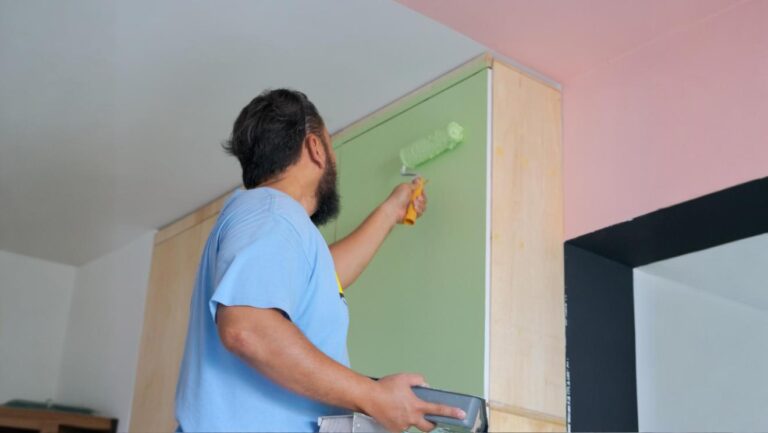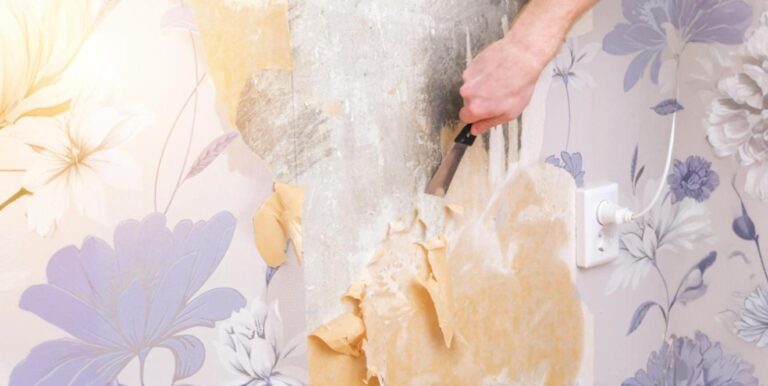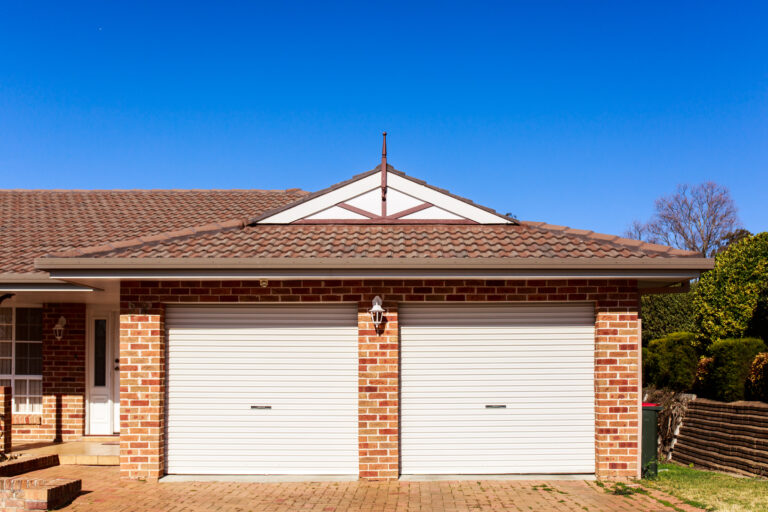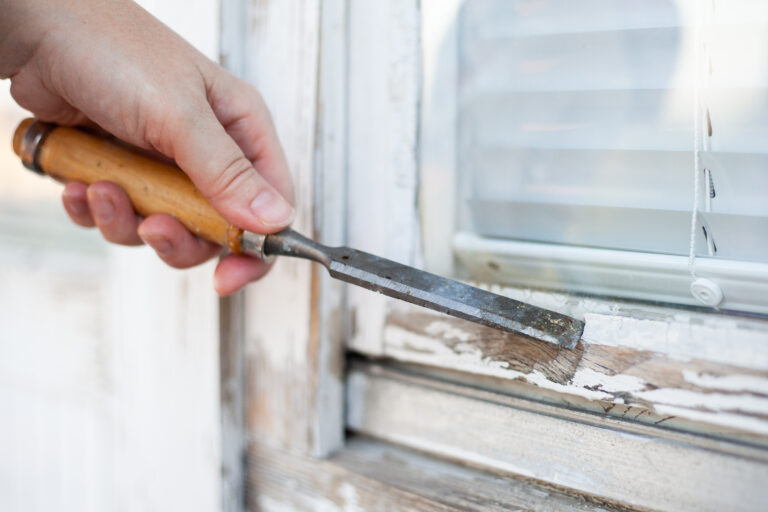Choosing the right porch paint involves more than just picking a pretty color. You need to consider durability, weather resistance, maintenance requirements, and how the color will complement your home’s existing features.
This guide covers the best wood porch paint ideas and walks you through everything you need to know about selecting and applying the perfect paint for your wooden porch. From understanding the difference between deck stains and traditional paint to discovering which colors work best in various climates, you’ll have all the information needed to make an informed decision that you’ll love for years to come.
Key Takeaways
- Quality deck paint provides superior durability for your entire deck surface compared to standard paint formulations
- Proper deck surface preparation prevents paint job failure, as skipping prep work leads to premature peeling within two years
- Choose porch paint colors that complement your home’s architecture, with whites working universally and bold colors creating focal points
- Most deck makeover projects require two coats for optimal protection, though premium paints may offer one coat coverage on prepared surfaces
- The best paint for your deck depends on climate, with hot areas needing UV protection and coastal regions requiring moisture resistance for your fresh coat
- Simple porches suit DIY projects, while complex multi-level surfaces benefit from professional expertise for the best deck results
Best Wood Porch Paint Ideas for Every Style
Traditional Home Color Schemes
Traditional homes benefit from classic color schemes that have stood the test of time. Crisp white remains the most popular choice for porch floors and railings, offering a clean, fresh appearance that complements virtually any house color. This timeless option reflects heat well in summer climates and provides an excellent backdrop for colorful furniture and plants.
For homeowners seeking something more distinctive, consider soft gray tones that add sophistication without overwhelming your outdoor space. Light gray porch paint creates a modern feel while maintaining enough neutrality to work with various decorating styles. These colors hide dirt and wear better than pure white, making them practical choices for high traffic areas.
Bold Color Choices for Statement Porches
Bold homeowners might explore darker shades like deep blue, forest green, or rich brown. These dramatic choices work particularly well on covered porches where UV exposure is limited.
Navy blue porch paint paired with white trim creates a striking nautical theme, while deep greens complement homes surrounded by lush landscaping. Rich brown options provide warmth and help hide everyday wear effectively.
Natural Wood Tone Finishes
Natural wood tones achieved through semi-transparent stains offer another appealing option. These finishes highlight the wood’s natural grain while providing protection from the elements. Popular choices include:
- Honey oak for warm, inviting spaces
- Cedar tones for rustic appeal
- Redwood shades that blend beautifully with natural surroundings
Choosing the Perfect Color for Your Outdoor Space
Architectural Style Considerations
Your home’s architectural style should guide your color selection process. Victorian homes with ornate details often look stunning with traditional white or cream porch paint that highlights intricate woodwork.
Craftsman-style houses pair beautifully with earth tones like sage green, warm brown, or muted gold that complement their natural materials and horizontal lines.
Landscape and Environmental Factors
Consider your landscape when selecting porch paint colors. Homes surrounded by mature trees might benefit from deeper tones that won’t show falling leaves and debris as readily. Properties with colorful flower gardens can handle neutral porch colors that won’t compete with blooming plants throughout the seasons.
The amount of natural light your porch receives significantly impacts how colors appear. North-facing porches tend to receive cooler, indirect light that can make warm colors appear muted. South-facing outdoor spaces get intense direct sunlight that can wash out pale colors or cause dark colors to absorb excessive heat.
Coordinating with Existing Elements
Your existing exterior elements should also influence your decision. Consider:
- Roof color compatibility
- Siding material coordination
- Window trim harmony
- Front door color balance
Take photos of your home and test paint samples in different lighting conditions before making your final choice.
Top Deck Paint Options That Actually Last
Premium Coating Systems
Premium coating systems stand out as excellent choices for high-traffic outdoor surfaces. These products function more like coatings than traditional paint, providing thick coverage that can hide minor imperfections in older wood. The formulas include subtle non-slip textures that improve safety around pools and in wet conditions.
High-Quality Paint Options
High-quality latex enamel paints offer excellent options for porch painting projects. These formulations provide outstanding adhesion and color retention, making them ideal for both covered and exposed porches. This premium quality paint resists fading, chalking, and mildew growth while maintaining its appearance through multiple seasons.
Oil based deck stains and paints generally last longer than their water-based counterparts. These products penetrate deeper into wood fibers, providing better protection against moisture and UV damage. They take longer to dry and may require primer for optimal adhesion on previously painted surfaces.
Modern acrylic formulations have improved dramatically, offering many benefits of oil based products with easier cleanup. These paint products work well for most climates and provide excellent color retention. Look for formulas specifically designed for deck surface application, as they include additives that improve durability and slip resistance.
Professional Paint Job vs. DIY: What You Need to Know
Essential Preparation Requirements
Painting a porch requires careful preparation and the right tools to achieve professional-looking results. The deck surface must be thoroughly cleaned, often with a power washer, before any paint or stain application. Loose or peeling paint needs complete removal, and any damaged boards should be replaced before beginning your paint job.
Weather conditions play a vital role in painting success. Avoid painting during high humidity, extreme temperatures, or when rain is expected within 24 hours. Most deck paint products require specific temperature ranges for proper curing, typically between 50-85 degrees Fahrenheit.
When to Choose Professional Help
Consider hiring professionals like OnDemand Painters when your project involves extensive prep work, multiple levels, or intricate railings. Professional painters have the experience and equipment to handle challenging projects efficiently while ensuring proper surface preparation and paint application techniques.
DIY projects work well for simple, single-level porches when you have adequate time and the right tools. Budget extra time for preparation work, which often takes longer than the actual painting. Remember that shortcuts in prep work usually result in paint failure within a year or two, making professional results worth the investment for many homeowners.
Deck Stains vs. Paint: Making the Right Choice
Semi-Transparent Deck Stains
Semi-transparent deck stains allow wood grain to show through while providing excellent protection against moisture and UV damage. These products penetrate into the wood rather than forming a surface film, making them ideal for newer wood. The finish tends to fade gradually rather than peeling, making maintenance easier over time.
Solid Color Stain Options
Solid color stain provides more coverage than semi-transparent options while still allowing some wood texture to show through. This choice works well for older decks with minor imperfections or when you want more color options than natural wood tones. Solid stains typically last longer than semi-transparent versions but require more thorough prep work for reapplication.
Traditional Deck Paint
Traditional deck paint creates a solid, opaque finish that completely covers wood grain and imperfections. This option offers the widest range of color choices and typically provides the longest-lasting protection when properly applied. Paint forms a surface film that can chip or peel if moisture gets underneath, requiring complete removal for refinishing.
Consider your maintenance preferences when choosing between stains and paint. Stains generally require reapplication every 2-3 years but can often be applied over existing finishes with minimal prep work. Paint may last 3-5 years but requires more extensive preparation for reapplication, including scraping and priming in many cases.
Best Paint Color Combinations for Porches
Classic White Combinations
Creating the perfect color scheme involves balancing your porch floor with railings, trim, and other architectural elements. Classic white porch paint on floors paired with colored railings creates timeless appeal that works with virtually any house style. This combination allows you to introduce personality through railing colors while keeping the main surface neutral and practical.
Off-White and Neutral Options
Off white shades offer more warmth than pure white while maintaining the clean, fresh appearance that makes porches feel welcoming. Colors like cream, ivory, or antique white hide dirt slightly better than bright white and complement both traditional and contemporary home styles. These versatile choices work particularly well with natural wood trim or colorful door options.
Bold Blue Statement Colors
Bold blue porch paint creates stunning visual impact, especially when paired with crisp white railings and trim. Navy blue works beautifully on covered porches where heat absorption isn’t a concern, while lighter blues suit exposed areas better. This color choice complements homes with white, gray, or natural wood siding particularly well.
Earth Tone Combinations
Earth tone combinations using browns, tans, and warm grays create sophisticated outdoor spaces that blend seamlessly with natural surroundings. A rich brown porch floor with cream railings and dark green shutters establishes a welcoming, grounded feeling that works year-round. These combinations hide wear and dirt effectively while maintaining visual interest.
Paint Ideas for High Traffic Areas
High traffic porches require paint formulations that can withstand constant foot traffic, furniture movement, and weather exposure. Choose products specifically designed for floor applications, as these contain additives that improve durability and resist scuffing.
Matte sheen finishes hide imperfections better than glossy surfaces but may require more frequent touch-ups in heavily used areas.
Color Choices That Hide Wear
Darker colors naturally hide dirt, scratches, and wear marks better than light colors. Medium brown, charcoal gray, or deep green porch paint can maintain their appearance longer between maintenance cycles. Dark colors absorb more heat, which can make surfaces uncomfortably hot in direct sunlight.
Safety Considerations
Consider adding texture to your paint for improved slip resistance in wet conditions. Many deck paint products include subtle texture, or you can add sand-like additives to create a safer walking surface. This becomes particularly important for stairs and areas around pools where safety concerns outweigh purely aesthetic considerations.
Plan for easy touch-up maintenance by keeping detailed records of paint colors and purchasing extra paint for future use. High traffic areas will inevitably show wear, but having matching paint readily available allows for quick touch-ups. Store leftover paint properly to maintain its quality for future use.
Selecting the Best Deck Paint for Your Climate
Hot, Sunny Climate Requirements
Hot, sunny climates demand paint formulations with superior UV protection and heat resistance. Light-colored paints reflect sunlight better than dark options, helping keep surfaces cooler and reducing thermal expansion. Look for products specifically rated for high UV exposure when living in desert or tropical regions.
Coastal Environment Considerations
Coastal areas with high humidity and salt exposure require paint with excellent moisture resistance and corrosion protection. Marine-grade paints or those specifically formulated for coastal environments provide better long-term performance. These products typically cost more initially but save money over time by lasting longer between repainting cycles.
Freeze-Thaw Climate Needs
Regions experiencing freeze-thaw cycles need flexible paint formulations that can expand and contract without cracking or peeling. Oil based products generally handle temperature fluctuations better than water-based options, though modern acrylic formulations have improved significantly. Proper surface preparation becomes even more important in these challenging climates.
Winter weather considerations include snow load capacity and ice formation effects on painted surfaces. Choose durable formulations that can handle snow removal tools and ice melt chemicals without damage. Plan painting projects for optimal weather windows to ensure proper curing before harsh conditions arrive.
Off White and Neutral Porch Paint Schemes
Off white paint colors provide the fresh, clean appearance of white while offering subtle warmth that feels more inviting. Popular choices include Benjamin Moore’s Cloud White, which has slight gray undertones, or Decorator’s White, which leans slightly cream. These choices work beautifully with both warm and cool color palettes throughout your home’s exterior.
Creating Sophisticated Neutral Schemes
Neutral schemes using various shades of gray, beige, and cream create sophisticated outdoor spaces that never go out of style. A light gray porch floor with white railings and cream trim establishes a calming, spa-like atmosphere perfect for relaxation. These combinations photograph beautifully and appeal to most potential homebuyers if resale value concerns you.
Creating depth within neutral palettes involves using different tones of the same color family rather than identical shades throughout. A warm beige porch floor might pair with slightly darker beige railings and cream trim for subtle variation. This approach works particularly well on larger porches where solid color could feel monotonous.
Consider your interior wall colors when selecting exterior neutrals to create flow between indoor and outdoor spaces. Extending similar color palettes from interior rooms to your porch helps blur the lines between indoor and outdoor living. This makes both areas feel larger and more connected.
Finding Your Perfect Color Match
Modern color tools and smartphone apps allow homeowners to visualize paint colors on their porches before making final decisions. Benjamin Moore’s Color Portfolio app and similar tools let you upload photos of your porch and try different colors virtually. While these tools provide helpful guidance, nothing replaces testing actual paint samples in your specific lighting conditions.
Testing Paint Samples
Purchase small sample sizes of your top color choices and paint large swatches directly on your porch boards. Observe these samples at different times of day and in various weather conditions. What looks perfect in morning light might appear completely different in afternoon sun or evening shade.
Consider how seasonal changes affect color appearance in your outdoor space. Colors that work beautifully surrounded by green summer foliage might look different against autumn leaves or bare winter branches. Think about which seasons you spend most time on your porch and weight those considerations accordingly.
Professional color consultation can prove invaluable for homeowners struggling with color decisions or working with challenging color combinations. Color experts understand how different hues interact and can suggest combinations you might not have considered while avoiding costly mistakes.
Best Color Choices for Different Porch Styles
Victorian Porches
Victorian porches with ornate details benefit from classic white or cream colors that highlight intricate woodwork without competing for attention. These traditional choices complement the elaborate trim work and decorative elements typical of Victorian architecture. Consider using slightly different white tones on floors versus railings to create subtle definition while maintaining the classic aesthetic.
Modern Minimalist Porches
Modern minimalist porches work beautifully with clean, simple color schemes using whites, grays, or single bold accent colors. A sleek gray porch floor with white railings and black trim creates the crisp, uncluttered look that defines contemporary design. These combinations photograph well and appeal to homeowners seeking sophisticated simplicity.
Country Farmhouse Styles
Country farmhouse styles work well with warmer, more relaxed color palettes including soft yellows, sage greens, and weathered blues. These choices complement the casual, comfortable feeling that defines farmhouse design while working beautifully with natural wood elements. Vintage-inspired furniture typically found on country porches pairs perfectly with these color schemes.
Colonial and Traditional Homes
Colonial and traditional homes pair perfectly with historically appropriate colors like deep blues, forest greens, and classic whites. These time-tested combinations honor the architectural heritage while providing lasting appeal that won’t feel dated in future years. Research historical color palettes for your home’s specific architectural period for authentic inspiration.
Conclusion
Transforming your porch with the right paint choice creates an outdoor space that improves your home’s beauty while providing years of enjoyment. Whether you choose classic white, sophisticated gray, or bold color statements, success depends on selecting quality products appropriate for your climate and usage patterns.
Remember that proper preparation and application techniques matter just as much as color selection for achieving professional-looking results.
The investment in premium quality deck paint or stains pays dividends through longer-lasting beauty and reduced maintenance requirements. While DIY projects can provide satisfaction and cost savings, complex projects often benefit from professional expertise.
Companies like OnDemand Painters bring the experience and tools needed to handle challenging installations while ensuring optimal results that protect your investment for years to come.
Start your porch transformation by carefully evaluating your home’s style, climate requirements, and personal preferences. Take time to test color samples thoroughly and consider how your choices will work with existing elements and future decorating plans. With thoughtful planning and quality materials, your newly painted porch will become a favorite gathering spot that adds value and enjoyment to your home.
FAQs
What type of deck paint works best for outdoor wood surfaces?
High-quality acrylic or oil-based deck paint specifically formulated for exterior use provides the best protection and durability.
How should I prepare my deck surface before painting?
Clean the deck surface thoroughly with a power washer, remove loose paint, and replace any damaged boards before application.
Can I achieve good coverage with just one coat of paint?
Premium deck paints may provide one coat coverage on well-prepared surfaces, though most projects benefit from two coats.
What is the best paint brand for deck refinishing projects?
The best paint depends on your climate and needs, with marine-grade formulations working well in coastal areas and UV-resistant options for sunny regions.
How long does deck paint typically last before needing reapplication?
Quality deck paint lasts 3-5 years with proper preparation and application, depending on climate and traffic levels.
Should I hire professionals or do the deck painting myself?
Professional painters ensure proper surface preparation and application techniques that maximize paint longevity, making them worth the investment for most deck projects.






